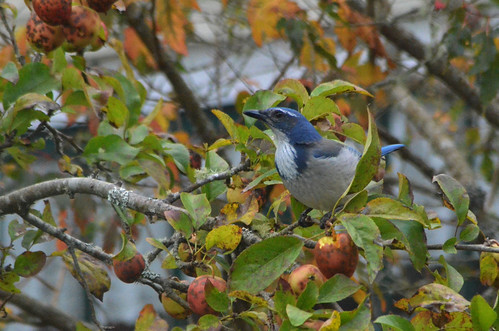There are currently 3 recognized species in the North American Scrub-jay complex, Western Scrub-jay, Island Scrub-jay and Florida Scrub-jay. The latter two represent distinct, disjunct populations that have unequivocal structural and behavior differences from the broadly distributed Western Scrub-jay, not to mention very well defined, isolated ranges and little or no chance of overlap between them to muddy identification. This may soon change with the addition of two additional scrub-jay species that have ranges and field marks that are not so neatly demarcated.
Depending on who you want to believe there are somewhere between 8 and 14 subspecies under the Western Scrub-jay umbrella, all of which fall into one of three larger groups: California Jay, Woodhouse's Jay and a Mexican form called Sumichast's Jay (Curry et al. 2002; Pyle 1997). There is growing genetic evidence that these three groups may represent three distinct species.
The latest evidence comes from a paper published in BMC - Evolutionary Biology: Speciation in Western Scrub-jays, Haldane's rule, and genetic clines in secondary contact (Gowen, et al. 2014). The study was designed to test gene flow along the zone of contact between interior (Woodhouse's) and coastal (California) Scrub-jays by exploring the mechanisms of Haldane's Rule. As we all probably learned in High School biology, hybridization between two species generally produces offspring which are either sterile or have significantly reduced fertility. This is a mechanism of reproductive isolation that helps to define different species.
Haldane's rule applies to incomplete reproductive isolation. Again, going back to High School Biology, gender is determined in most animal species through a difference in the combination of sex chromosomes. For mammals, XX produces females (homogametic gender) and XY produces males (heterogametic gender). In birds, females are the heterogametic gender. The letters ZW are traditionally used for female heterogametic species (ZZ would be males). Haldane noted that, in many cases of incomplete isolation at hybrid zones, hybrid offspring of the heterogametic gender are much more likely to be absent, rare or sterile than the homogametic gender. This complicates genetic studies for birds, because mitochondrial DNA (mtDNA), which is only inherited from the mother, is passed to next generation at a much lower rate than nuclear DNA which can be passed by both males and females. Avian genetic studies which use only mtDNA may misrepresent the degree of gene flow along contact zones.
So, the Gowen, et al. study collected 689 specimens from throughout the range of Western Scrub-jay. They sequenced both mtDNA and nuclear DNA to compare rates of gene flow along zones of contact and were ultimately able to demonstrate a statistically significant difference in the rate of mtDNA movement along the zone of contact when compared to nuclear DNA as predicted by Haldane's Rule.
In the process, they were able to do the most comprehensive, range-wide genetic sequencing study to date on Western Scrub-jays. The study shows a strong genetic difference between Coastal and Interior Scrub-jays with a narrow zone of hybridization that exhibits partial reproductive isolation along heterogametic lines (Haldane's Rule).
| Structure scans from 13 nuclear microsatellite loci highlighting genetic clusters (from: Gowen, et al. 2014) |
This supports the proposition that Coastal and Interior forms are separate species. The study further showed that the Western Scrub-jays in southern Mexico also qualify for elevation to at least one species (and arguably three, pending more study).
This study did not sample any of the scrub-jays in Central or Eastern Oregon and provides no direct guidance into the status of birds in interior Oregon or Washington. Birds occurring in Klamath and Harney County are presumed to be from the Coastal group based on phenotypic and behavioral characters. Coastal Scrub-jays show bright blue upper parts and white under parts. They also show a well defined blue necklace and a heavy bill. These birds are also strongly associated with residential areas in eastern locations. Interior (Woodhouse's) Scrub-jays are a dull blue with very gray under parts, little or no necklace and a narrow bill. This group is sparsely distributed in pinyon-juniper scrub.
Any claims of Woodhouse's Scrub-jay in Oregon or Washington should be meticulously documented with photos and comprehensive notes on habitat and behavior.
References
Curry, Robert L., A. Townsend Peterson and Tom A. Langen. 2002. Western Scrub-Jay (Aphelocoma californica), The Birds of North America Online (A. Poole, Ed.). Ithaca: Cornell Lab of Ornithology; Retrieved from the Birds of North America Online: http://bna.birds.cornell.edu/bna/species/712
Gowen, F. C., Maley, J. M., Cicero, C., Peterson, A.T., Faircloth, B.C., Warr, T. C. and McCormack, J.E.. 2014. Speciation in Western Scrub-Jays, Haldane’s rule, and genetic clines in secondary contact. BMC Evolutionary Biology 2014, 14:135
Pyle, P. 1997. Identification Guide to North American Birds. Slate Creek Press, Bolinas, CA.




